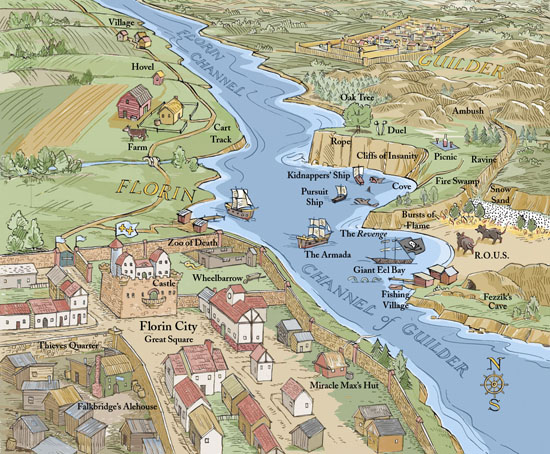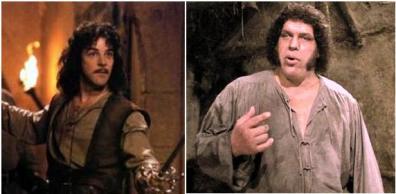Twenty five years ago we were first warned against two classic blunders, “The most famous of which is “never get involved in a land war in Asia*,”” but the Princess Bride has far more to offer strategic thinkers.
Before delving into lessons, it’s worth establishing that none of the strategy comes from an actual war. Instead, and much like In the Loop, the entire film concerns the machinations of a government to justify starting a war. (Unlike In the Loop, the rest of story is about resisting those machinations, rescuing a princess, and something about True Love?). Prince Humperdinck, confident of his ability to win and eager for glory, wants a war against neighboring Guilder, and with this in mind he manages to get his fiance kidnapped (and, later, [spoilers] attempts to get her killed). Now, on to the lessons!
False Flags
When Princess Buttercup is kidnapped by Vizzini, Inigo Montoya, and Fezzik (all of whom are in the employ of Florin), they place insignia torn from the uniforms of Guilder soldiers on her horse. Then, they take her across the narrow sea and it’s eel-infested waters to Guilder itself. Ideally, this would have been all Humperdinck needed: a kidnapping + known attackers = war! No such luck, as his plan was stymied by…
Piracy
The Dread Pirate Roberts operates, like many self-made non-state actors, in the ungovernable spaces of the world. As a trade in which to learn security, nothing beats piracy, especially given the Renaissance setting. As a captive,** Westly was able to watch how power was exercised first hand, all while acutely aware of his own imminent demise. As the successor to a long line of Dread Pirate Roberts, he learned that a fearsome reputation has a utility all its own, and that it’s easier to maintain a reputation than build one. Besides the reputation, Westly built up a variety of martial skills suitable for those in less reputable work – swordfighting of course, but also a knowledge of poison (and an immunity to some), a willingness and ability to navigate ungovernable spaces, and a first-rate ability for bluffing. Also: perhaps this was learned from his time as a captive, but Westly is perfectly willing to dispatch his opponents with non-lethal force. In return, this ends up paying off big, as those he defeated without killing eventually seek him out and join his cause.
Waterboarding
After defeating Buttercups’ captors, Westley leads her down a gorge and through the fire swamp. After surviving snowsand, bursts of flame, and Rodents of Unusual Size, Westley and Buttercup are confronted by a superior number of pursuers at the edge of the swamp. While Westley intends for them to return to the fireswamp, Buttercup instead offers to surrender in exchange for Humperdinck’s promise to spare Westley’s life. (Quick sublesson: somepeople will trade a lot for stability, others never will, and those with all the weapons are free to renege on promises they made once they’ve disarmed their opposition.) Instead of escaping, Westly finds himself captured and subject to an experimental pain machine. The purpose behind his torture is not for the extraction of any information (well, besides data points for Count Rugen’s study of pain), but to break the man before killing him. It’s arbitrary, horrific, and leaves him mostly dead. Beyond cruel, the torture program is less useful than execution. Being only mostly dead, Westly is rescued, and revived.
Accidental Guerrillas
Westly is rescued from the dungeon by two armed goons formerly contracted to Prince Humperdinck. The first, the giant Fezzik, had been recruited into the brute squad the king formed to clear the Thieves Quarter (itself a loosely-governed place that Humperdinck at times draws mercenaries at covert services from, and at other times declares a threat to the very survival of Florin and his bride.)*** Upon finding his fellow kidnapper Inigo Montoya in the Thieves Quarter, Fezzik abandons his post and turns on his former employer, driving the brute squad away and quitting their ranks. Fezzik’s reason for turning is simple: it was easier to side with a friend than to jail him.**** Inigo Montoya’s motives for resisting are multiple: first, no one skilled and armed and drunk likes getting caught up in a sweep; displacement is rarely a smooth process. Secondly, Inigo Montoya is so driven by revenge that he is practically synonymous with it. Inigo seeks the help of the man who bested him in order to continue his quest for revenge. Driven by friendship and feeling no sympathy for the king that sought to turn them against each other, drove them from their home, and (in Inigo’s case) killed their family, Fezzik and Montoya turn to Westley, despite the lack of an ideological tie to his cause.
Deception
Three men do not an insurgency make, but a mastermind, an expert swordsman, a giant, a wheelbarrow, and a holocaust cloak are certainly enough to give the appearance of one. Using the holocaust cloak, wheelbarrow, and giant, Westley is able to scare away a guard detail at the gate numbering 50 men, and force the regiment’s leader to hand over the keys to the gate. Once inside the palace, the security detail is overwhelmed. The prince is left alone, while Count Rugen, Humperdinck’s chief of intelligence and right hand man, attempts to flee. Humperdinck is confronted by a reclining Westley, who manages to take being barely able to move and play it off as an elaborate ruse, all while threatening a horrific sort of death following their duel. Humperdinck blinks first and flees, only to be knocked unconscious as his captive princess bride is freed.
Targeted Killings
Meanwhile, Inigo Montoya confronts and pursues Count Rugen, who killed Inigo Montoya’s father rather than pay a fair price for the custom sword Diego Montoya had made him. Inigo witnessed his father’s murder, vowed revenge on the spot, and in return had Count Rugen scar his face. Since that day, Inigo Montoya had trained and traveled so that he may better be able to fulfill his vow. Inigo’s object was Count Rugen’s death, and he was willing to join a three-man assault on a castle to get it. People other than his died along the way (Montoya honing his skills without life being on the line? Inconceivable!), but ultimately he killed the right six fingered man.
~
It is worth noting that, while it has the trapping of soldiers and kings, the entirety of Princess Bride concerns law enforcement, irregular forces, and covert warfare. On the 25th anniversary of the film’s release, it’s worth noting that everything new in war is old again.
Commenters: I’m certain I missed lessons, like an easy metaphor about Fezzik’s fighting style being unsuited for a duel. What other strategic wisdom can we gain from this?
Footnotes and asides:
*Fun fact: when Princess Bride first came out, Russia was currently in its 8th year in Afghanistan and things weren’t going smoothly. But for the 25th anniversary edition, the United States (along with others) is in its 11th year in Afghanistan, where things do not appear to be going smoothly. The “fun” in this fact comes from the amount of whiskey you’ll need to drink to forget it.
**Depending on Westly’s age at the time of his captivity, it’s entirely possible he’s a child soldier in service of a warlord who will have suffered Stockholm Syndrome and is now a warlord himself. In case you were wondering how I was going to work a Joseph Kony reference into this, there it is.
***Insert FATA/Pakistan joke here.
****Here’s the green on blue joke. I…I’m sorry.

